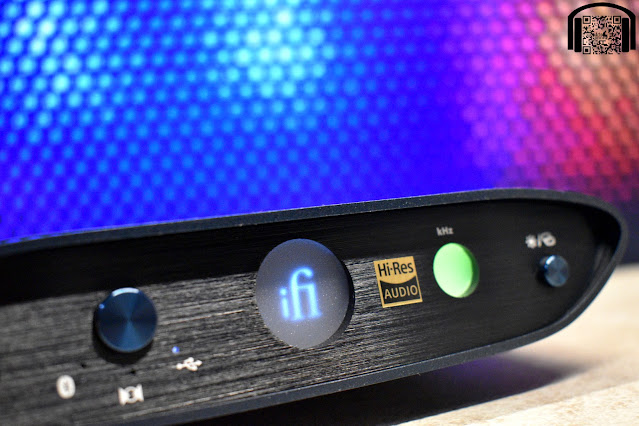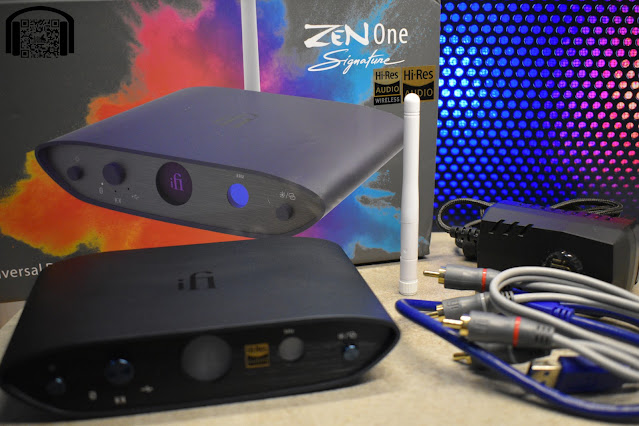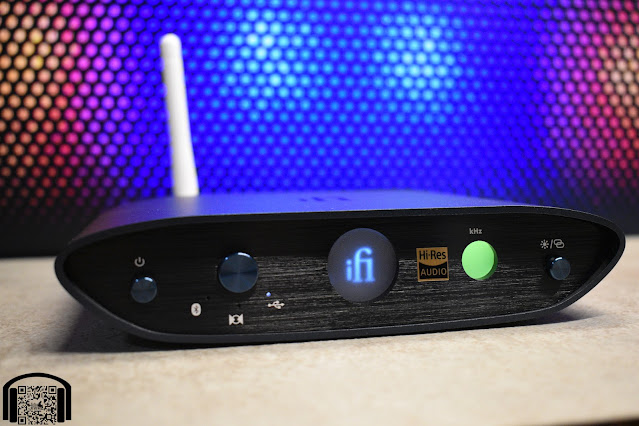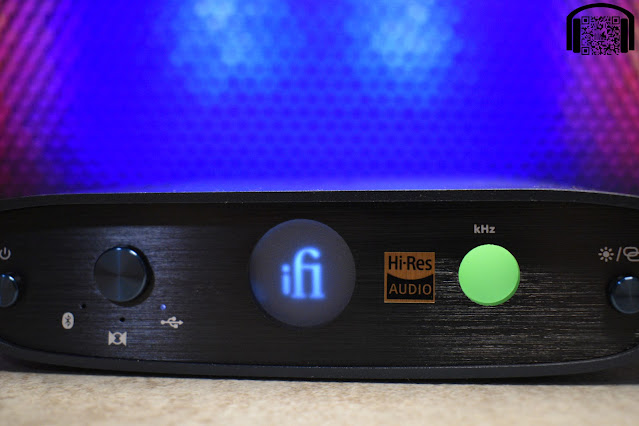- Get link
- X
- Other Apps
English | Español
TLDR version on YouTube: TDLR - iFi Audio ZEN One Signature
The Zen One Signature has been sent to me directly by iFi Audio for me to try it out and to publish this review. There have been no requests or comments from iFi and I will do my best, as always, to be as unbiased as possible in my review.
The official page for the iFi Zen One Signature can be found here: https://ifi-audio.com/products/zen-one-signature/
(non-affiliate link)
Intro…
The Zen One Signature is a DAC that comes in at just under 350€, placing it quite a bit above some of the recent devices I have reviewed from the brand, but still in the lower tiers of their price ranges (which range from under 100€ all the way up to over 2500€).
The Zen One Signature (which I am going to refer to as the Z1S for brevity) is a pure DAC, in other words there is no headphone amplifier in this device, nor is there a volume control, which follows the general aesthetics and build of the Zen line.
According to iFi, the Z1S is built using the DAC stage from the Zen DAC v2, adding additional digital inputs (although with some caveats that I will get to), based around a Burr Brown chipset which is the usual (although not only) way that iFi present their house sound.
Presentation…
At this point, I have unpacked many iFi devices and the experience is usually the same, being just the contents that differ. That is to say, well packaged, in a simple, no frills, manner. This doesn’t mean that it is cheaply packed, just that they opt for simplicity and functionality, making sure everything is well packaged without going overboard.
In case you have not seen any of my previous iFi reviews, the packaging is a simple white box inside a cardboard sleeve that shows the device on the front and specifications on the back.
In the case of the Z1S, inside the box we get the device, the power supply (an iPower II), a short USB 3 cable, an RCA to RCA cable, a Bluetooth antenna, along with the usual simple user guide and iFi sticker.
While some will complain that there is no balanced cable included, especially as 4.4mm to dual XLR cables are not the easiest things to source, I feel that the contents are fair and I am happy to see the inclusion of a decent power supply.
Build and aesthetics…
While the ZEN line uses the same shape and form for all of its models, there are slight differences between the different models, mainly the colour and the material of the finish. In the case of the the Z1S, the exterior is a dark blue aluminum, with the iFi logo on the top, and a black brushed aluminum front and rear panel. This matches other Signature devices from the ZEN line but does vary in colour from the ZEN Stream (which uses a grey case and silver brushed panels). It would be nice to see the ZEN Stream available in a couple of different finishes to match up with things like the Signature line.
The styling of the ZEN line is no longer anything new, as it has been around for quite some time, but it is still unique, standing out from other brands and models, with aesthetics that I actually like. It has a sort of retro/modern combination going on, which always attracts the eye to it (whether you like it or not), without being overly loud about it.
On the front we do have two rather large lights that illuminate and change colour depending on the input and output formats, the center one showing the iFi logo when illuminated. White I am not a huge fan of the size of the input format LED (the one on the left), it is very easy to see from a distance and is also not overly bright to the point where it is problematic if placed under a TV, monitor, etc.
As with all iFi products that I have had my hands on, it is well built and shows no signs of corners being cut in the construction.
All in all, the build and aesthetics of the device are typical iFi and I have absolutely no issue with that.
Functionality…
Before getting into the functionality of the device, which is not always as straightforward as it looks, let’s take a look at the connections and controls of the Z1S.
Starting on the rear, from left to right, we have:
- 4.4mm Balanced analogue output
- RCA Unbalanced analogue output
- Coaxial SPDIF input/output
- Optical Input
- USB 3 input
- Bluetooth antenna
- Power supply input
Moving around to the front, again from left to right, we have:
- Power button
- Source selector button
- Digital Audio Format LED
- Input Audio Format LED
- Bluetooth pairing and display on/off button
The analogue connections are pretty straight forwards, the 4.4mm gives you a balanced output which you can connect to an external amplifier (headphone or speaker), although you will need to supply the cable, either a 4.4mm to 4.4mm or 4.4mm to dual XLR, depending on the input of the amplifier.
The RCA output is obviously an unbalanced output with which you can do the same thing, just with an unbalanced connection.
The SPDIF Coaxial connection functions as either an input or an output. If the source is set to SPDIF, then this connector is automatically an input. If the source is set to either USB or Bluetooth, then this connector automatically becomes an output, allowing you to convert USB or BT to a digital connection to feed another DAC.
The Optical input only functions as an input (again, when SPDIF is selected as a source) and will not output. It is also worth noting that both the Coaxial and Optical inputs are on the same input selection, meaning that you cannot choose between them. If you have both connectors receiving an input, then Coaxial will take priority. In other words, if you have something playing that is connected to the Optical input, then you feed something into the Coaxial input, the device will switch to the Coaxial source.
However, when you stop playing the Coaxial source, it will not switch back to the Optical, you either need to disconnect the Coaxial cable or reboot the device. This is not a great option if you are someone who wants to use both of the inputs but if you are only feeding the device with one or the other, then it works fine.
I like the USB/BT DDC option (converting it to Coaxial), although, in my case, I would have actually liked the Optical output instead of the Coaxial. I understand that this is a completely personal scenario though. This function is very useful if you have the DAC feeding a headphone amplifier, with the source from a PC or cell phone, and then you can use the Coaxial output to feed a main speaker system, or into a receiver etc. Thus adding BT and USB functionality to any existing DAC.
While I am not a huge user of Bluetooth (except when in my car or when moving around a lot), I found the connection to be very stable, with good reception and distance, allowing me to go into the room adjacent to my office without it losing connection or experiencing any drop outs.
As far as formats, the Z1S accepts PCM (up to 192kHz), DSD (up to 12.3MHz), DXD (352.8/384kHz), MQA and Bluetooth 5.1 (aptX, aptX HD, aptX Adaptive, aptX LL, LDAC, LHDC/HWA, AAC and SBC). So you should be covered no matter what kind of format you are wanting to use.
Sound…
I find describing the sound of a DAC is difficult to say the least. It is a combination of what my brain tells me I should be hearing, what my ears think I am hearing and a lot of descriptive words that don’t actually make much sense. It has been said many times (and tested many times) that in a blind test, it is very difficult, or almost impossible, to identify different DACs unless there is something wrong with one of them.
However, in a sighted test, in other words, knowing what we are listening to, the brain adds its own data and makes us hear things that maybe we don’t actually hear. Is this an issue? Personally I don’t believe it is. Music is about enjoyment and if we are enjoying something, what does it matter whether the enjoyment is coming from specs on paper or fantasies in our brains, just sit back and enjoy it. It is sort of like tasting something in a dish that isn’t actually in the ingredients, if we like the dish, who cares?
And the Z1S is about enjoyment, at least that is how I feel about it after using it for the past few weeks and trying it with a variety of different amplifiers (both with headphones and speakers).
I get the impression that the Z1S presents more of the “warm iFi flavour” than many other of their DACs and combos. It doesn’t seem to be quite as detailed when paired with very resolving amplifiers but does give a more “rounded” presentation to the music. This is not to say that it isn’t detailed, nothing is lacking, it just doesn’t seem to focus on it. My usual way of referring to this in terms that make sense to me but probably doesn't to others, is like when a track has been mastered. By this, I am referring to making a recording where you have multiple tracks with instruments and vocals, each with their own processing going on, and then you master the final track and it becomes one, smoother, finalized track.
Something I have found with the Z1S which seems to be much more apparent than with some of the other DACs I have tried from the brand is synergy. Yes, that is another term that many people will roll their eyes at but I did find that I found myself enjoying the Z1S more paired with certain amplifiers than with others.
In fact, one of my favourite pairings, which was completely unexpected, is with the JDS Labs Atom. I only actually tried this pairing by pure accident. When I received the Z1S at my office, I hadn’t really looked into it at all (nothing surprising there) and didn’t know it was only a DAC, for some reason I automatically thought it was a combo. So, I opened it up, grabbed the Kiwi Ears Quintet (which I have been trying out and will review soon), and then proceeded to not find a connection point for the IEMs.
The Atom lives on my desk (fed from a Modi 3+) and is basically my permanent feed for the KPH40, which I use for conference calls, simple media consumption etc. throughout the day. Rather than be patient, I took the Atom and plugged the unbalanced feed from the Z1S to it and proceeded to enjoy the rest of the day. I actually enjoyed the combination so much that, although I brought another couple of amplifiers into the office, it was a few days before I finally got around to swapping out the amp.
With the Atom, the Z1S just seems to present a very clear, precise and yet warm signature, something that I really enjoy for my preferred music genres (which is mainly focused on vocals and acoustic instruments).
While I used the Quintet a lot, I also used the KPH40, the Hifiman HE1000se, the Sennheiser IE600, the Hifiman Svanar and the Hifiman Edition XS, all of which are headphones/IEMs that are easily driven and, in most cases, reflective of sources (at least in my brain).
Other amplifiers that I liked with these IEMs/headphones and fed by the Z1S were the Asgard 3 and the iFi Gryphon, both of which seemed to synergise well with the Z1S. However, I did find that things like the 789 or the L30 came across sounding a little digital and harsher. I know that this is to be expected due to the way these amplifiers are by nature (which is why I like using the 789 for tests) but I still found them a little more “digital” sounding than I would have expected (if that makes any sense), based on the natural warmth that the Z1S seems to portray.
When paired with the Echo Mk2, which is already warmer due to the nature of the tubes, I found the result to be nice but I wouldn’t say it is the best pairing I have heard with this amplifier. Things seemed to be a little too rounded off for my tastes.
One last thing to note is that the output of the Z1S, from the unbalanced RCA’s, is over 3V, which is quite a bit more than the usual approx 2V output of an unbalanced connection. This can actually cause clipping on the input of certain amplifiers, depending on the design of their preamp stage. As there is no volume control on the Z1S, you would need to drop down the source to avoid this if it is your case.
It is also worth noting that, while the Z1S will work with just a USB connection, when powered by the included power supply, there is a noticeable increase in volume. This increase in volume actually also seems to increase the clarity and separation, yet this is probably just the mind interpreting it that way due to the volume increase. Perceived or real, I have to say that I prefer it with the iPower II in use.
Conclusion…
Once again, while there shouldn’t be much to say about a DAC, I find myself rambling on and making the review much longer than a review of some headphones!
In short, I find that the ZEN One Signature is a very enjoyable DAC that will fit well in systems of those who want to have good quality and not get caught up in the analysis of the smallest nuances of music. Those who listen to music for joy and not to dissect it.
I found it was a stable piece of equipment that worked well in multiple scenarios, both feeding speakers and headphones (obviously with an amplifier between them), giving a very enjoyable and overall pleasant sound.
There are a couple of things, such as not being able to use both the Optical and Coaxial input (or rather, not being able to switch between them), that may or may not influence your decision on this device but I can see it being a very sensible purchase for those who have a simple but decent system and are looking for a decent and easy to use DAC to feed it.







